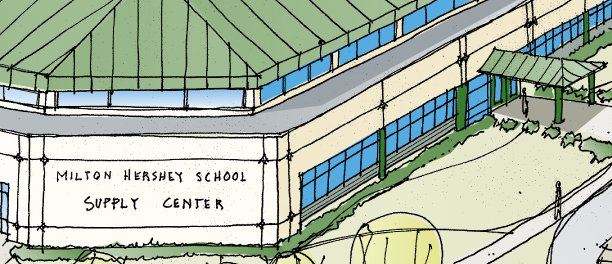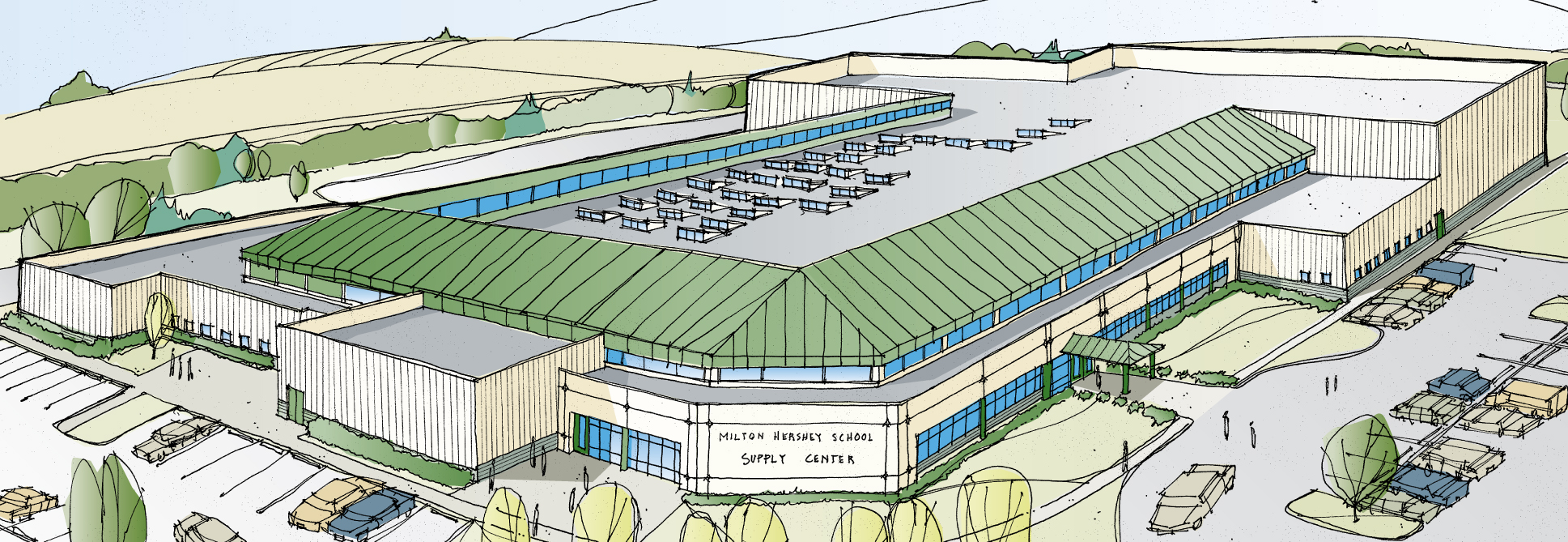Building Statistics
Building Name:
The Milton Hershey School New Supply Center
Location and Site:
Meadow Lane and Rout 322
Derry Township, Dauphin County, PA. 17033
The project site is located on the Milton Hershey School’s campus in Hershey Pennsylvania. The New Supply Center is located next to The Milton Hershey School’s operation center just off of Bachmanville Road.
Building Occupant Name:
The New Supply Center is owned and operated by The Milton Hershey School.
Size:
The one story building is approximately 110,000 square feet, with 4 elevated mechanical mezzanine rooms. The large majority of the Supply Center, approximately 50,000 square feet, is occupied with the food production center for the Milton Hershey School’s student housing and academic buildings. The remaining area of the building includes storage space and a small clothing store.
Number of Stories Above Grade/ Total Levels:
The New Supply Center is one story above grade with elevated mechanical mezzanine rooms to house the mechanical and electrical equipment for the building.
PRIMARY PROJECT TEAM:
Building Owner/Operator:
The Milton Hershey School
Architect: Spillman Farmer Architects Structural Engineer: Barry Isett and Associates, INC.
MEP:
H.F. Lenz Company
Civil/Site Development Engineers:
Pennoni Associates, INC.
Food Service and Storage Systems Designer:
Orlando Espinosa and Associates
Telecommunications:
H.F. Lenz Company
General Contractor/CM:
The Quandel Group
Dates of Construction:
Start – July 2006
Completion – July 2007
Cost Information:
Overall Project Cost Estimate: $23,500,000
Project Delivery Method:
Design-Bid-Build
ARCHITECTURE:
Design and Functional Components/Construction:
The Milton Hershey School New Supply Center contains a variety of spaces. One section of the Supply Center consist of six general offices, a conference room, a dining facility, male and female locker rooms for the employees, and a break room.
The food distribution center for the Milton Hershey School is also located in the New Supply Center and consists of a central kitchen, bakery shop, a butcher area, and storage for food, dishes, silverware, and paper products. The food distribution area also contains large freezers, refrigerators, and temperature controlled storage areas, fifteen in all, totaling to 13,600 square feet.
Aside from the food production section of the building, the New Supply Center also includes a central mail distribution center for the school and a clothing store with an alterations work area.
There are 4 mechanical mezzanine rooms that house the air handling units for the supply center as well as a boiler and chiller plant.
Major Building Model Codes/Standards:
2003 International Building Code
ASHRAE Standard 62.1 for Indoor Air Quality
ASHRAE Standard 90.1
All Applicable National Fire Protection Association Standards
Zoning:
New Construction zoning by Derry Township, Dauphin County PA
Building Envelope:
The building envelope of the New Supply Center consists of 6” structural metal studs, gypsum board interior wall finish, R-19 foil-faced fiberglass insulation, gypsum sheathing cover, and 1-1/2” deep metal vertical wall panels for the exterior finish. This wall assembly connects to split face CMU’s totaling one foot thick a few feet from grade which then transfers to 12” CMU below grade down to the footing. The windows elevated on the building are aluminum casement windows with 1” tinted insulating glass. The windows lower on the building are aluminum storefront framing with 1” insulated glass.
The interior portion of the building has a lower roof than the exterior. This section of roof consist of a flat 1-1/2” metal deck with a layer of rigid insulation, a layer of overlay tapered insulation sloped at 1/4"/foot, and a layer of EPDM Roofing Membrane for water proofing and finishing. This area of the roof also contains 27 clearstory light shafts. These light shafts have a 12-6 roof slope with EPDM roofing and 3” insulation connected to 6” structural lightweight framing studs and 1/2" gypsum board interior finish. The vertical walls of the light shafts that extend above the roof are constructed from 3-5/8” structural metal studs with EPDM roofing on the exterior.
The exterior perimeter of the building has a different roofing system than the interior portion. This section has a 12-3 sloped roof that rises higher than the interior roof so to hide any roof top mechanical equipment. This roofing system can be seen at ground level so the finished roofing consist of standing seam metal roof panels connected to 3” insulation and a 1-1/2” metal deck.
PRIMARY ENGINEERING SYSTEMS:
MECHANICAL:
The air side mechanical system for the Supply Center uses fourteen air handling units all of which are located on four elevated mechanical mezzanine rooms. All but two of the air handling units are controlled by variable frequency drives making these twelve air handlers part of a variable volume system. Four of the VAV air handlers serve the kitchen area, the loading dock, and the bakery. These four air handlers are demand based 100% outdoor air units used to provide make-up air to these spaces. When the kitchen is not operating, the outdoor air intake is backed down to the minimum amount. The trash area, not served by a VFD, is also a 100% outdoor air unit but not variable volume.
The mail rooms, offices, break rooms, locker rooms, the clothing store, and the clothing alterations sections of the building contain variable air volume boxes for individual space conditioning control. These VAV boxes contain hot water reheat coils. The food service sections of the building do not use VAV boxes. These air handlers modulate the amount of air needed to meet both ventilation and cooling and heating loads with the variable frequency drive.
Aside from the air handling units, horizontal unit heaters and cabinet unit heaters are used in restrooms and entrance lobby areas. Ductless air cooled split system units are also used in the two IT rooms in the Supply Center.
The chiller plant consists of two (one duty one standby) 270 ton electric centrifugal water cooled chillers operating at 45˚F. These chillers handle the building load and supply chilled water to the fourteen air handling units. Along with the building load chillers, the plant also contains two electric (one duty one standby) water cooled brine chillers operating at 20˚F. These brine chillers are nominally 75 ton chillers when they produce 45 degree water, however, the chillers supply 20 degree water to serve fan coil units located in the walk-in coolers year round. Since these chillers operate at lower temperatures, the actual load the chiller sees is lowered from 75 tons to 35 tons. These chillers are separate from the water cooled condensing units serving the walk-in freezers.
Also included in the chiller plant are three heat exchangers. One heat exchanger is used in the winter time for water side “free” cooling. The building load centrifugal chillers also pick up rejected heat from the walk-in freezer’s water cooled condensing units through the other two heat exchangers.
The boiler plant includes three gas fired fire tube boilers, two 200 boiler horse power boilers and one 125 BHP boiler, producing 40 psig medium pressure steam to serve both the building load and process loads in the kitchen. The boilers have a gross out put of 6695 MBH for the two larger boilers and 4184 MBH for the smaller. Low pressure steam enters two heat exchangers (one duty one standby) which convert the steam to hot water which is used for space heating. The medium pressure steam is used to serve dishwashing in the kitchen and bakery.
The New Supply Center’s mechanical systems utilize energy saving techniques and these assist in the project’s goal of LEED Certification (26-31 points).
ELECTRICAL:
The Milton Hershey Supply Center electric service is distributed from a 480/277V three phase switchboard. The main distribution panel is rated at 2000 amps. The electrical service is installed in the main electrical room. Power is supplied from this room to five 480V panels located throughout the building, four of which are located in the elevated mechanical mezzanine rooms. The other 480V panel is the life safety distribution panel. Each distribution panel includes a 480 to 208/120V step-down transformer. 480/277V panels serve main mechanical equipment and 120V or 277V panels serve the building lighting and basic power loads.
For emergency power, a 750 kW diesel fueled emergency generator serves the emergency/life safety demand on the building. The generator serves equipment such as emergency egress lighting, fire alarm panels, and essential heating and cooling equipment.
LIGHTING:
A variety of lighting fixtures are used in the Supply Center. The offices, work areas, kitchen, mail room, and locker rooms use 277V fluorescent lighting fixtures with one to four 32 watt T-8 lamps. The lighting fixtures are 2x4 recessed troffers. The clothing section of the building uses 2x2 recessed troffers with two 31 watt T-8 U lamps.
In the freezers and refigerators, fully gasketed, totally enclosed 1x4 surface mounted fixtures are used with 2 T-8 lamps. These lighting fixtures also require cold weather ballast.
The storage and receiving rooms in the Supply Center use pendent fixtures with two 32 watt T-8 lamps. The exterior lighting for the building consists of ground mounted or wall mounted fixtures with metal halide lamps of either 39 or 70 watts.
STRUCTURAL:
The structural system for the New Supply Center consists of steel columns, beams, and girders supporting the roofing system. Steel floor beams support the concrete floor of the elevated mechanical mezzanine rooms. There are interior load bearing masonry walls as well that help support portions of the mezzanine rooms. These beams carry the load to the girders which connect to the steel columns.
The Supply Center flooring is 5” concrete slab on grade. The floor slabs are 4000 psi concrete while other concrete used on the project are rated at 3000 psi.
The roofing system consists of K-series steel joist supporting the metal roof deck. These joist tie into steel roof beams and girders which transfer the roof load to the steel columns.
CONSTUCTION:
The Milton Hershey School Supply Center was a design-bid-build project delivery method. The design of the building was completed in May of 2006. The bids were rewarded in July of 2006 and construction started in mid July 2006. The Supply Center is under construction as of now and its projected completion date is July of 2007.
FIRE PROTECTION:
The Supply Center will be fully protected from fire with a sprinkler system. The freezer and refrigerator areas contain a dry pipe or double interlock preaction sprinkler system to prevent freezing. The loading dock and trash disposal areas have a dry pipe sprinkler system. All other areas such as the mechanical and electrical areas, the kitchen, and the bakery have a wet pipe sprinkler system for fire protection. Areas of the building with ceilings use fully concealed pendant type sprinkler heads. Areas without ceilings use upright sprinkler heads with a protective cage guard.
TELECOMMUNICATIONS:
Telecommunications systems for the Supply Center include an intercom system, an analog phone system connected to the rest of the Milton Hershey School, cable television for the employee break rooms and training rooms, and wireless internet.
The fiber optic cables handling the telecommunication services will branch from an existing telecom manhole and be fed to the building through new a new ductbank. The main cables will run above the ceilings in runways until finally terminating in the main data room located in approximately the center of the building.
SPECIAL SYSTEMS:
A security system is installed at the New Supply Center and consists of cameras in all corridors and entrances as well as card readers, both interior and exterior, for building access at all entrances.

